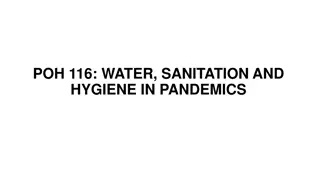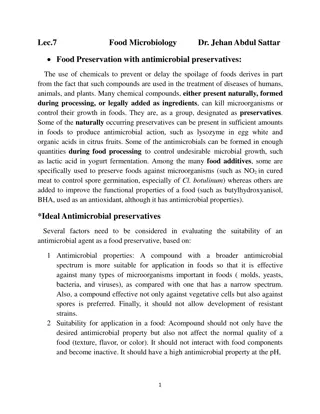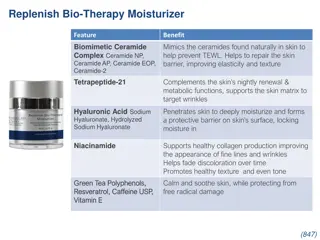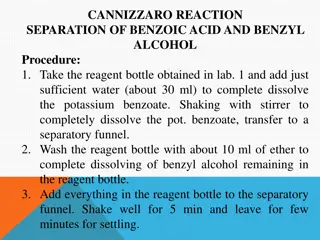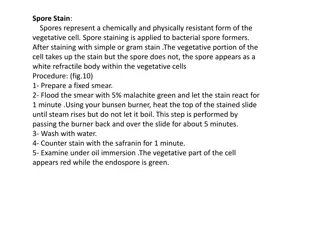
The Science Behind Salicylic Acid Face Wash and Its Effectiveness
In the ever-evolving world of skincare, few ingredients have stood the test of time quite like salicylic acid. Known for its powerful acne-fighting properties and its ability to rejuvenate the skin, salicylic acid is a staple in many facial cleansers
Download Presentation

Please find below an Image/Link to download the presentation.
The content on the website is provided AS IS for your information and personal use only. It may not be sold, licensed, or shared on other websites without obtaining consent from the author. Download presentation by click this link. If you encounter any issues during the download, it is possible that the publisher has removed the file from their server.
E N D
Presentation Transcript
The Science Behind Salicylic Acid Face Wash and Its Effectiveness In the ever-evolving world of skincare, few ingredients have stood the test of time quite like salicylic acid. Known for its powerful acne-fighting properties and its ability to rejuvenate the skin, salicylic acid is a staple in many facial cleansers. But what exactly makes it so effective? Let's delve into the science behind salicylic acid face wash and explore why it remains a cornerstone in skincare routines around the globe. Understanding Salicylic Acid Salicylic acid is a beta hydroxy acid (BHA) that is derived from willow bark. Unlike alpha hydroxy acids (AHAs), which are water-soluble, BHAs are oil-soluble. This unique characteristic allows salicylic acid to penetrate deeper into the pores of the skin, making it exceptionally effective for treating acne and other skin conditions that originate beneath the surface.
How Salicylic Acid Works 1. Exfoliation: One of the primary benefits of salicylic acid is its ability to exfoliate the skin. It works by breaking down the bonds between dead skin cells, which facilitates their removal from the surface. This not only helps to prevent clogged pores but also promotes a smoother, more radiant complexion. 2. Penetration: Due to its oil-soluble nature, salicylic acid can penetrate deep into the pores, where it dissolves sebum and other impurities. This deep-cleaning action helps to prevent the formation of blackheads and whiteheads, which are common precursors to more severe acne. 3. Anti-inflammatory Properties: Salicylic acid is also known for its anti-inflammatory properties. It can reduce the redness and swelling associated with acne, making it an effective treatment for inflammatory forms of acne, such as pustules and cysts. 4. Antimicrobial Action: Salicylic acid possesses antimicrobial properties that help to combat the bacteria responsible for acne. By reducing the bacterial load on the skin, it helps to prevent new breakouts from occurring. The Effectiveness of Salicylic Acid Face Wash 1. Acne Treatment The primary use of salicylic acid face wash is for the treatment of acne. Its ability to exfoliate the skin and penetrate deep into the pores makes it particularly effective for preventing and treating both blackheads and whiteheads. Additionally, its anti-inflammatory properties help to reduce the severity of active breakouts. Studies have shown that salicylic acid is highly effective in treating mild to moderate acne. A study published in the Journal of Clinical and Aesthetic Dermatology found that a 2% salicylic acid cleanser significantly reduced acne lesions and improved skin texture in participants over a period of 12 weeks. 2. Seborrheic Dermatitis
Seborrheic dermatitis is a common skin condition characterized by red, scaly patches, often on the scalp or face. Salicylic acid s keratolytic properties, which help to soften and shed the outer layer of skin, make it an effective treatment for this condition. By reducing scaling and inflammation, salicylic acid face washes can help to manage the symptoms of seborrheic dermatitis. 3. Psoriasis Psoriasis is another condition that can benefit from salicylic acid. This chronic skin disorder causes rapid skin cell turnover, leading to thick, scaly patches. Salicylic acid can help to reduce scaling and soften the plaques, making them easier to remove. Regular use of a salicylic acid face wash can help to manage the symptoms of psoriasis and improve the overall appearance of the skin. Choosing the Right Salicylic Acid Face Wash
When selecting a salicylic acid face wash, there are a few key factors to consider to ensure you get the most effective product for your skin type and concerns: 1. Concentration: Salicylic acid face washes typically contain concentrations ranging from 0.5% to 2%. For those new to using salicylic acid, starting with a lower concentration can help to minimize irritation. More severe acne may require a higher concentration. 2. Formulation: The formulation of the face wash can also impact its effectiveness. Gel-based cleansers are often recommended for oily and acne-prone skin, while cream-based formulations may be more suitable for those with dry or sensitive skin. 3. Complementary Ingredients: Look for face washes that include complementary ingredients, such as calming agents like aloe vera or chamomile, to help soothe the skin and reduce potential irritation. 4. pH Balance: The pH of the cleanser can affect the efficacy of salicylic acid. A slightly acidic pH, around 3-4, helps to maintain the stability and effectiveness of the salicylic acid. How to Use Salicylic Acid Face Wash Effectively To get the most out of your salicylic acid face wash, follow these tips: 1. Frequency: Start by using the face wash once a day, preferably in the evening. If your skin tolerates it well, you can gradually increase usage to twice a day. 2. Application: Apply the face wash to damp skin and gently massage it in circular motions for about 30 seconds. Avoid scrubbing, as this can cause irritation. 3. Rinse Thoroughly: Rinse the cleanser off thoroughly with lukewarm water. Make sure no residue is left behind, as this can lead to irritation. 4. Moisturize: Follow up with a gentle, non-comedogenic moisturizer to keep your skin hydrated and balanced. This helps to prevent dryness and irritation, which can be side effects of salicylic acid. 5. Sun Protection: Salicylic acid can make your skin more sensitive to the sun. Always use a broad-spectrum sunscreen with at least SPF 30 during the day to protect your skin from UV damage. Potential Side Effects and Precautions
While salicylic acid is generally safe for most skin types, it can cause some side effects, especially when used in high concentrations or too frequently. Common side effects include dryness, irritation, and peeling. To minimize these risks: Patch Test: Perform a patch test before using the product on your entire face. Avoid Overuse: Stick to the recommended usage frequency and concentration. Hydrate: Keep your skin well-hydrated with a suitable moisturizer. Consult a Dermatologist: If you have sensitive skin or any underlying skin conditions, consult a dermatologist before incorporating salicylic acid into your routine. Conclusion Salicylic acid face wash is a powerful tool in the fight against acne and other skin conditions. Its unique ability to exfoliate, penetrate pores, reduce inflammation, and
combat bacteria makes it an effective and versatile ingredient in skincare. By understanding the science behind salicylic acid and how to use it properly, you can achieve clearer, healthier skin. For more information on effective skincare solutions, visit Accufix Cosmetics and explore our range of products designed to meet your skin's unique needs.





